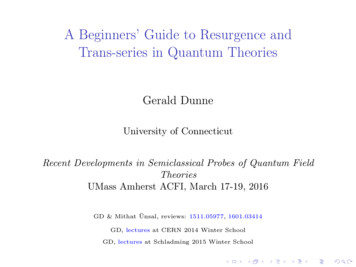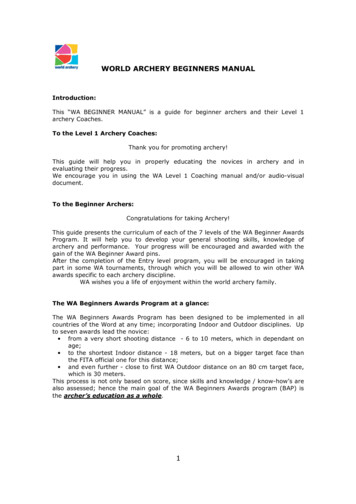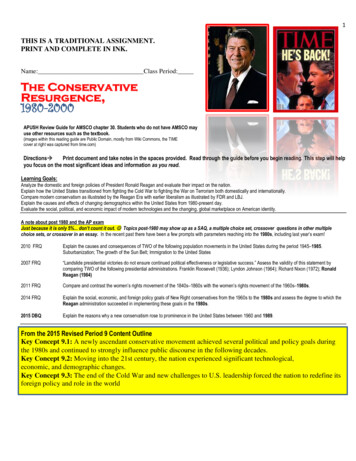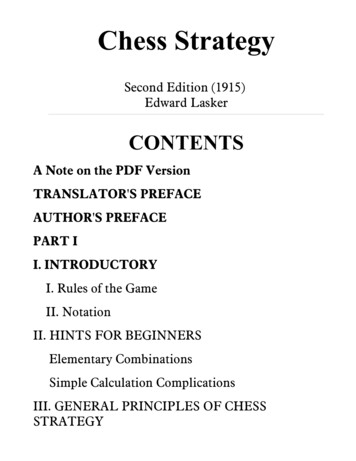
Transcription
A Beginners’ Guide to Resurgence andTrans-series in Quantum TheoriesGerald DunneUniversity of ConnecticutRecent Developments in Semiclassical Probes of Quantum FieldTheoriesUMass Amherst ACFI, March 17-19, 2016GD & Mithat Ünsal, reviews: 1511.05977, 1601.03414GD, lectures at CERN 2014 Winter SchoolGD, lectures at Schladming 2015 Winter School
Lecture 1Imotivation: physical and mathematicalItrans-series and resurgenceIdivergence of perturbation theory in QMIbasics of Borel summationIthe Bogomolny/Zinn-Justin cancellation mechanismItowards resurgence in QFTIeffective field theory: Euler-Heisenberg effective action
Physical Motivation infrared renormalon puzzle in asymptotically free QFT non-perturbative physics without instantons: physicalmeaning of non-BPS saddles "sign problem" in finite density QFT exponentially improved asymptoticsBigger Picture non-perturbative definition of non-trivial QFT, in thecontinuum analytic continuation of path integrals dynamical and non-equilibrium physics from pathintegrals uncover hidden ‘magic’ in perturbation theory
Physical Motivation what does a Minkowski path integral mean? ZZi1DA expS[A]versusDA exp S[A] 12πZ e i(1 3t x t3) dt 2 3/2 3 x e 2 π x1/4 23/2 π sin( 3 ( x) 1/4 4 )π ( x),x ,x
Physical Motivation what does a Minkowski path integral mean? ZZi1DA expS[A]versusDA exp S[A] 1.00.5-105-510-0.5-1.012πZ ei( 13 t3 x t)dt 2 3/2 3 x e 2 π x1/4 23/2 π sin( 3 ( x) 4 )π ( x)1/4,x ,x
Mathematical MotivationResurgence: ‘new’ idea in mathematics(Écalle, 1980; Stokes, 1850)resurgence unification of perturbation theory andnon-perturbative physics perturbation theory generally divergent series series expansion trans-series expansion trans-series ‘well-defined under analytic continuation’ perturbative and non-perturbative physics entwined applications: ODEs, PDEs, fluids, QM, Matrix Models, QFT,String Theory, . philosophical shift:view semiclassical expansions as potentially exact
Resurgent Trans-Series trans-series expansion in QM and QFT applications: k l 1cf (g ) ck,l,p gln 2exp 2gg {z }p 0 k 0 l 1{z} {z}perturbative fluctuations 2 X Xk 1X2pk instantonsquasi-zero-modes J. Écalle (1980): closed set of functions:(Borel transform) (analytic continuation) (Laplace transform) trans-monomial elements: g 2 , e 1g2, ln(g 2 ), are familiar “multi-instanton calculus” in QFT new: analytic continuation encoded in trans-series new: trans-series coefficients ck,l,p highly correlated new: exponentially improved asymptotics
Resurgenceresurgent functions display at each of their singularpoints a behaviour closely related to their behaviour atthe origin. Loosely speaking, these functions resurrect,or surge up - in a slightly different guise, as it were - attheir singularitiesJ. Écalle, 1980nm
Perturbation theory perturbation theory generally divergent seriese.g. QM ground state energy: E IZeeman: cn ( 1)n (2n)!IStark: cn (2n)!IP nn 0 cn (coupling)cubic oscillator: cn Γ(n 12 )Iquartic oscillator: cn ( 1)n Γ(n 12 )Iperiodic Sine-Gordon (Mathieu) potential: cn n!Idouble-well: cn n!note generic factorial growth of perturbative coefficients
Asymptotic Series vs Convergent Seriesf (x) N 1Xn 0cn (x x0 )n RN (x)convergent series: RN (x) 0,N ,x fixedasymptotic series: RN (x) x x0 N ,x x0,Nfixed“optimal truncation”:truncate just before the least term (x dependent!)
Asymptotic Series: optimal truncation & exponentialprecision X1 1( 1) n! x e x E1xnnn 0optimal truncation: Nopt RN (x) N 1/x N ! xN1x 1x exponentially small errorN 1/x N !N N e 1/xN e N 15(x 0.1)ææ20N24(x 0.2)68æN
Borel summation: basic ideawrite n! R 0dt e t tnalternating factorially divergent series: X( 1)n n! g n n 0Z0 dt e t11 gt(?)integral convergent for all g 0: “Borel sum” of the series
Borel Summation: basic idea X( 1)n n! xn 0n 01.2Z dt e t11 xt1.11.00.90.80.70.00.10.20.30.4x
Borel summation: basic ideawrite n! R 0dt e t tnnon-alternating factorially divergent series: Xn 0nn! g Z dt e t0pole on the Borel axis!11 gt(?)
Borel summation: basic ideawrite n! R 0dt e t tnnon-alternating factorially divergent series: Xn 0nn! g Z dt e t011 gt(?)pole on the Borel axis! non-perturbative imaginary part i π g1egbut every term in the series is real !?!
Borel Summation: basic idea BorelRe" Xn! xnn 0# PZ tdt e0111 e x Ei1 xtx2.01.51.00.50.5-0.51.01.52.02.53.0x 1x
Borel summationBorel transform of series f (g) B[f ](t) P n 0 cn g Xcnn 0n!n:tnnew series typically has finite radius of convergence.Borel resummation of original asymptotic series:Z1 Sf (g) B[f ](t)e t/g dtg 0warning: B[f ](t) may have singularities in (Borel) t plane
Borel singularitiesavoid singularities on R : directional Borel sums:1Sθ f (g) gZ0eiθ B[f ](t)e t/g dtC C-go above/below the singularity: θ 0 non-perturbative ambiguity: Im[S0 f (g)]challenge: use physical input to resolve ambiguity
Borel summation: existence theorem (Nevanlinna & Sokal)f (z) analytic in circle CR {z : z f (z) N 1Xan z n RN (z)n 0,R2 R2} RN (z) A σ N N ! z NBorel transformB(t) Xann 0n!R/2tnanalytic continuation toSσ {t : t R 1/σ}Z1 t/zf (z) eB(t) dtz 0Im(t)1/σRe(t)
Borel summation in practicef (g) Xcn g ncn β n Γ(γ n δ),n 0 alternating series: real Borel sum1f (g) γZ0 dtt 11 t tβg δ/γ" #t 1/γexp βg nonalternating series: ambiguous imaginary part" # δ/γZ dt1tt 1/γ1Re f ( g) Pexp γt 1 tβgβg0" # δ/γπ 11 1/γIm f ( g) exp γ βgβg
Resurgence and Analytic Continuationanother view of resurgence:resurgence can be viewed as a method for making formalasymptotic expansions consistent with global analyticcontinuation properties “the trans-series really IS the function”(question: to what extent is this true/useful in physics?)
Resurgence: Preserving Analytic Continuation zero-dimensional partition functions Z 1111 2λsinh2 ( λ x)4λdx eZ1 (λ) e K04λλ r 1 2XΓ(n 2 )π ( 1)n (2λ)nBorel-summable 22n! Γ 1n 0Z2 (λ) Z π/ λ2 1 2λsin2 ( λ x)dx e0 r Γ(n 21 )2πX(2λ)n 22n! Γ 12n 0 naively: Z1 ( λ) Z2 (λ)1π e 4λ I0λ 14λ non-Borel-summable
Resurgence: Preserving Analytic Continuation zero-dimensional partition functions Z 1111 2λsinh2 ( λ x)4λdx eZ1 (λ) e K04λλ r 1 2XΓ(n 2 )π ( 1)n (2λ)nBorel-summable 22n! Γ 1n 0Z2 (λ) Z π/ λ2 1 2λsin2 ( λ x)dx e0 r Γ(n 21 )2πX(2λ)n 22n! Γ 12n 01π e 4λ I0λ 14λ non-Borel-summable naively: Z1 ( λ) Z2 (λ) connection formula: K0 (e iπ z ) K0 ( z ) i π I0 ( z ) 1Z1 (e iπ λ) Z2 (λ) i e 2λ Z1 (λ)
Resurgence: Preserving Analytic Continuation Borel summationr Z t1 1π 1 2λZ1 (λ) dt e, , 1; t2 F12 2λ 02 2 directional Borel summation:Z1 (eiπ λ) Z1 (e iπ λ)r Z tπ 11 11 1 dt e 2λ 2 F1, , 1; t iε 2 F1, , 1; t iε2 2λ 12 22 2r Z t1 1π 1 1 e 2λ, , 1; t (2i)dt e 2λ 2 F12 2λ2 201 2 i e 2λ Z1 (λ) (Im 2 F1 21 , 21 , 1; t iε 2 F11 12 , 2 , 1; 1 t )1 connection formula: Z1 (e iπ λ) Z2 (λ) i e 2λ Z1 (λ)
Resurgence: Preserving Analytic ContinuationStirling expansion for ψ(x) ψ(1 z) ln z ddxln Γ(x) is divergent1111746111 ··· .2462z 12z120z252z6600z 20 functional relation: ψ(1 z) ψ(z) formal series 1z1Im ψ(1 iy) 2y π2
Resurgence: Preserving Analytic ContinuationStirling expansion for ψ(x) ψ(1 z) ln z ddxln Γ(x) is divergent1111746111 ··· .2462z 12z120z252z6600z 20 functional relation: ψ(1 z) ψ(z) formal series 1z1Im ψ(1 iy) 2y reflection formula: ψ(1 z) ψ(1 z) π21z π cot(π z) Xπ1e 2π k yIm ψ(1 iy) π2y2k 1“raw” asymptotics inconsistent with analytic continuationresurgence fixes this
Transseries Example: Painlevé II (matrix models, fluids . )w00 2w3 (x) x w(x),w 0 as x x asymptotics: w σ Ai(x)σ real transseries parameter (flucs Borel summable)!2n 12 3/2 Xe 3 xw(x) σ 1/4w(n) (x)2 πxn 0p x asymptotics: w x2 transseries exponentials: exp 2 3 2 ( x)3/2imag. part of transseries parameter fixed by cancellations Hastings-McLeod: σ 1 unique real solution on R
Borel Summation and Dispersion Relationscubic oscillator: V x2 λ x3z 2I1E(z)dz2πi Cz z0ZIm E(z)1 R dzπ 0z z0 Z X1 RIm E(z)n z0dzπ 0z n 1E(z0 ) .zoRCA. Vainshtein, 1964n 0
Borel Summation and Dispersion Relationscubic oscillator: V x2 λ x3z A. Vainshtein, 19642I1E(z)dz2πi Cz z0ZIm E(z)1 R dzπ 0z z0 Z X1 RIm E(z)n z0dzπ 0z n 1E(z0 ) .zoRCn 0WKB Im E(z) cn e b/z azaπZ0 dz,z 0e b/za Γ(n 21 ) π bn 1/2z n 3/2X
Instability and Divergence of Perturbation Theoryquartic AHO:V (x) x244 λ x4Bender/Wu, 1969
recall: divergence of perturbation theory in QMe.g. ground state energy: E P n 0 cn (coupling) Zeeman: cn ( 1)n (2n)! Stark: cn (2n)! quartic oscillator: cn ( 1)n Γ(n 21 ) cubic oscillator: cn Γ(n 12 ) periodic Sine-Gordon potential: cn n! double-well: cn n!n
recall: divergence of perturbation theory in QMe.g. ground state energy: E P n 0 cn (coupling)n Zeeman: cn ( 1)n (2n)!stable Stark: cn (2n)!unstable quartic oscillator: cn ( 1)n Γ(n 21 )stable cubic oscillator: cn Γ(n 12 )unstable periodic Sine-Gordon potential: cn n!stable ? double-well: cn n!stable ?
Bogomolny/Zinn-Justin mechanism in QM. degenerate vacua: double-well, Sine-Gordon, .splitting of levels: a real one-instanton effect: E e Sg2
Bogomolny/Zinn-Justin mechanism in QM. degenerate vacua: double-well, Sine-Gordon, .splitting of levels: a real one-instanton effect: E esurprise: pert. theory non-Borel summable: cn Istable systemsIambiguous imaginary partI i e 2S2g, a 2-instanton effect n!(2S)nSg2
Bogomolny/Zinn-Justin mechanism in QM. degenerate vacua: double-well, Sine-Gordon, .1. perturbation theory non-Borel summable:ill-defined/incomplete2. instanton gas picture ill-defined/incomplete:I and Ī attract regularize both by analytic continuation of coupling ambiguous, imaginary non-perturbative terms cancel !
Bogomolny/Zinn-Justin mechanism in QMe.g., double-well: V (x) x2 (1 g x)2E0 perturbation theory:cn 3n n!:XBorelcn g 2nn Im E0 π e non-perturbative analysis: instanton: g x0 (t) classical Eucidean action: S0 6g12 non-perturbative instanton gas: 2Im E0 π e13g 211 e t16g 2 BZJ cancellation E0 is real and unambiguous“resurgence” cancellation to all orders
Decoding of Trans-series2f (g ) X Xk 1Xn 0 k 0 q 0cn,k,q g2n k qS1exp 2ln 2ggP2n perturbative fluctuations about vacuum: n 0 cn,0,0 gn! divergent (non-Borel-summable): cn,0,0 α (2S)n ambiguous imaginary non-pert energy i π α e 2S/g but c0,2,1 α: BZJ cancellation !2
Decoding of Trans-series2f (g ) X Xk 1Xn 0 k 0 q 0cn,k,q g2n k qS1exp 2ln 2ggP2n perturbative fluctuations about vacuum: n 0 cn,0,0 gn! divergent (non-Borel-summable): cn,0,0 α (2S)n ambiguous imaginary non-pert energy i π α e 2S/g but c0,2,1 α: BZJ cancellation !pert flucs about instanton: e S/g21 a1 g 2 a2 g 4 . . .divergent: n! 3S/g 2 a ln 1 ban (2S)(alnn b) iπeng2 22a11 3S/g 3-instanton: e b ln g2 c2 ln g 22
Decoding of Trans-series2f (g ) X Xk 1Xn 0 k 0 q 0cn,k,q g2n k qS1exp 2ln 2ggP2n perturbative fluctuations about vacuum: n 0 cn,0,0 gn! divergent (non-Borel-summable): cn,0,0 α (2S)n ambiguous imaginary non-pert energy i π α e 2S/g but c0,2,1 α: BZJ cancellation !pert flucs about instanton: e S/g21 a1 g 2 a2 g 4 . . .divergent: n! 3S/g 2 a ln 1 ban (2S)(alnn b) iπeng2 22a11 3S/g 3-instanton: e b ln g2 c2 ln g 2resurgence: ad infinitum, also sub-leading large-order terms2
Towards Resurgence in QFTQM: divergence of perturbation theory due to factorial growthof number of Feynman diagramsQFT: new physical effects occur, due to running of couplingswith momentum asymptotically free QFT faster source of divergence: “renormalons” (IR & UV)QFT requires a path integral interpretation resurgence: ‘generic’ feature of steepest-descents approx. saddles, real and complex, BPS and non-BPS
Divergence of perturbation theory in QFT C. A. Hurst (1952); W. Thirring (1953):φ4 perturbation theory divergent(i) factorial growth of number of diagrams(ii) explicit lower bounds on diagrams F. J. Dyson (1952):physical argument for divergence in QED pert. theoryF (e2 ) c0 c2 e2 c4 e4 . . .Thus [for e2 0] every physical state is unstableagainst the spontaneous creation of large numbers ofparticles. Further, a system once in a pathological statewill not remain steady; there will be a rapid creation ofmore and more particles, an explosive disintegration ofthe vacuum by spontaneous polarization. suggests perturbative expansion cannot be convergent
Euler-Heisenberg Effective Action (1935)review: hep-th/0406216. 1-loop QED effective action in uniform emag field the birth of effective field theory 2 2 B 2Eα 1 2 2 2 E B 7 E·B .L 290π Ec2 encodes nonlinear properties of QED/QCD vacuumthe electromagnetic properties of the vacuum can bedescribed by a field-dependent electric and magneticpolarisability of empty space, which leads, for example,to refraction of light in electric fields or to a scatteringof light by lightV. Weisskopf, 1936
QFT Application: Euler-Heisenberg 1935 Borel transform of a (doubly) asymptotic series resurgent trans-series: analytic continuation B ER EH effective action Barnes function ln Γ(x)
Euler-Heisenberg Effective Action: e.g., constant B fieldB2S 28πZ 0dss2 m2 s1 sexp coth s s 3B B2 X2B 2n 2B2n 4S 22π(2n 4)(2n 3)(2n 2) m2n 0 characteristic factorial divergencecn ( 1)n 1 X Γ(2n 2)8(k π)2n 4k 1 reconstruct correct Borel transform: Xs11 s 2 coth s k 2 π 2 (s2 k 2 π 2 )2ss 3k 1
Euler-Heisenberg Effective Action and Schwinger EffectB field: QFT analogue of Zeeman effectE field: QFT analogue of Stark effectB 2 E 2 : series becomes non-alternatinghi2 2 P 1k m2 πexp Borel summation Im S e8πE3k 1 k2eE
Euler-Heisenberg Effective Action and Schwinger EffectB field: QFT analogue of Zeeman effectE field: QFT analogue of Stark effectB 2 E 2 : series becomes non-alternatinghi2 2 P 1k m2 πexp Borel summation Im S e8πE3k 1 k2eEThe European Physical Journal DSchwinger effect:recent technologicaladvanc2eE refinements2mc2theoreticalof tmction, suggestthatlaserssu may be able to reach this e3m2 chasThisthe potential to opEc of experiments, 1016 V/cmwith the prWKBtunnelingfromDirac seag. 1. Pairproductionas theseparationof a virtual vacuume eriesandpracticalapplicatole pairundertheinfluenceofanexternalelectricfield.Im S physical pair production ratetalks in this conference. Euler-Heisenberg series must be divergentmptotic e e pairs if they gain the binding energy of2
QED/QCD effective action and the “Schwinger effect” formal definition:Γ[A] ln det (i D/ m)Dµ µ ieAµ c vacuum persistence amplitude iihOout Oin i expΓ[A] exp{Re(Γ) i Im(Γ)} encodes nonlinear properties of QED/QCD vacuum vacuum persistence probability 222 hOout Oin i exp Im(Γ) 1 Im(Γ) probability of vacuum pair production 2 Im(Γ) cf. Borel summation of perturbative series, & instantons
Schwinger Effect: Beyond Constant Background Fields constant field sinusoidal orsingle-pulse envelope pulse withsub-cycle structure;carrier-phase effect chirped pulse; Gaussianbeam , . envelopes & beyond complex instantons (saddles) physics: optimization and quantum control
Keldysh Approach in QEDBrézin/Itzykson, 1970; Popov, 1971 Schwinger effect in E(t) E cos(ωt) adiabaticity parameter: γ me cEωhi2 3 WKB PQED exp π me cE g(γ)PQED h exp π m2 c3e Ei 2e E 4mc / ωωmc,γ 1 (non-perturbative),γ 1 (perturbative) semi-classical instanton interpolates between non-perturbative‘tunneling pair-production” and perturbative “multi-photon pairproduction”
Scattering Picture of Particle ProductionFeynman, Nambu, Fock, Brezin/Itzykson, Marinov/Popov, . over-the-barrier scattering: e.g. scalar QED φ̈ (p3 e A3 (t))2 φ (m2 p2 )φ i mbp ap “imaginary time method” pair production probability: P Rimd3 p bp 2 imaginary time method Iq2222 bp exp 2 Im dt m p (p3 eA3 (t)) more structured E(t) involve quantum interference
the envelope of the oscillations in the distribution functiong probis related to the temporal width of the slits. The width of thee quanenvelope of oscillations thus also becomes a probe of theses noHebenstreit, Alkofer, GD, Gies, PRL 102, 2009subcycle structure of the laser.ter. WeTo complete the physical picture, we consider the overmakesall envelope of the longitudinal momentum distribution,mentumagain for " ¼ 0, averaging over the rapid oscillations.own inWhen there are more than three cycles per pulse (! *unction3), the peak of the momentum2 distribution is located nearhat, forpk ð1Þ ¼ 0, whereas for ! & 3 the peak is shifted to aillatorynonzero value. Furthermore,2 the Gaussian width of thefset inemployede, howpffiffiffiffiffiffiffiffi WKB approximation Eq. (4), which scales is obviously somewhat broader than thewith eE0 ,field istrue distribution, as is shown in Fig. 5. We can quantifyc distrithis discrepancy in the width, by extending the WKB resulte oscilbeyond the Gaussian approximation inherent in Eq. (4). Wea directPHYSICAL REVIEW LETTERSmmetric PRL 102, 150404 (2009)1414o is the5 105 14105 10perfectomenta,produc14143 14103 10ts from 3 10r-phaseesting a14141 10rch for 1 101 1410Carrier Phase Effect tE(t) E exp cos (ωt ϕ)τ sensitivity to carrier phase ϕ ?week ending17 APRIL 2009k MeV0.60.40.200.20.40.6 k MeVood in a0.40.200.20.40.6as firstFIG. 5. Comparison of the asymptotic distribution 1Þ for k ?function3.distribution function fðk;¼0ioniza- FIG. 1ÞAsymptoticfðk;for k ¼ 0 (oscillating solid line) with the prediction¼ 5, E0 ¼? 0:1Ecr , and " ¼ !# 4. The center of theure, the for of! Eq.(4) (dotted line) and the improved WKB kum thatbased on an expansion ofEq. (5) (dashed line) for ! ¼ 5, E0 ¼0:1Ecr , and " ¼ 0.ed pairsensitive dependence on the other shape parameters, suchas !.150404-3ϕ 00.40.200.20.40.6k MeV 1Þ for k ? ¼ 0FIG. 4. Asymptotic distribution function fðk;for ! ¼ 5, E0 ¼ 0:1Ecr , and " ¼ !# 2. The center of thedistribution is shifted to pk ð1Þ % 137 keV.ϕ π2creation events. The fringes are large for " ¼ !# 2, sincethen the field strength has two peaks of equal size (though
Carrier Phase Effect from the Stokes Phenomenon442200-2-2-4-4-4-202-44-2 interference produces momentum spectrum structureinterferencet P 4 sin2 (θ) e 2 ImWt θ: interference phase double-slit interference, in time domain, from vacuum Ramsey effect: N alternating sign pulses N -slit system coherent N 2 enhancementAkkermans, GD, 2012024
Worldline InstantonsGD, Schubert, 2005To maintain the relativistic invariance we describe atrajectory in space-time by giving the four variablesxµ (u) as functions of some fifth parameter (somewhatanalogous to the proper-time)Feynman, 1950 worldline representation of effective action Z T IZZ dT m2 T24eDx exp dτ ẋµ Aµ ẋµΓ d xT0x0 double-steepest descents approximation: worldline instantons (saddles): ẍµ Fµν (x) ẋν S(T ) T m2X2Im Γ e Ssaddle (m ) proper-time integral:saddles multiple turning point pairs complex saddles
Divergence of derivative expansionGD, T. Hall, hep-th/9902064 time-dependent E field: E(t) E sech2 (t/τ ) 2k Γ(2k j)Γ(2k j 2)B2k 2jm4 X ( 1)j Xk 2EΓ 3/2( 1)2j2(mλ)m8πj!(2k)!Γ(2k j 21 )j 0k 2 Borel sum perturbative expansion: large k (j fixed):(j)ck 2(j)Im ΓΓ(2k 3j 12 )(2π)2j 2k 2 4 jm πm2 π 1 exp Ej! 4τ 2 E 3 resum derivative expansion m2 π1 m 2Im Γ exp 1 .E4 Eτ
Divergence of derivative expansion Borel sum derivative expansion: large j (k fixed):(k)cj 29 2k2Im Γ(k) Γ(2j 4k 25 )(2π)2j 2k(2πEτ 2 )2k 2πmτe(2k)! resum perturbative expansion: EτIm Γ exp 2πmτ 1 .m compare: m2 π1 m 2Im Γ exp 1 .E4 Eτh2 different limits of full: Im Γ exp mE π g derivative expansion must be divergentmEτ i
Lecture 2Iuniform WKB and some magicIresurgence from all-orders steepest descentsItowards a path integral interpretation of resurgenceIlarge NIconnecting weak and strong couplingIcomplex saddles and quantum interference
Resurgence: recall from lecture 1 what does a Minkowski path integral mean? ZZi1S[A]versusDA expDA exp S[A] perturbation theory is generically asymptotic resurgent trans-series k l1cck,l,p gf (g ) ln 2exp 2gg {z }p 0 k 0 l 1 {z} {z}perturbative fluctuations2 X Xk 1X2pk instantonsnmquasi-zero-modes
The Bigger Picture: Decoding the Path Integralwhat is the origin of resurgent behavior in QM and QFT ?nmto what extent are (all?) multi-instanton effects encoded inperturbation theory? And if so, why? QM & QFT: basic property of all-orders steepest descentsintegrals Lefschetz thimbles: analytic continuation of pathintegrals
Towards Analytic Continuation of Path IntegralsThe shortest path between two truths inthe real domain passes through thecomplex domainJacques Hadamard, 1865 - 1963
All-Orders Steepest Descents: Darboux Theorem all-orders steepest descents for contour integrals:hyperasymptoticsI(n)2(g ) Z dz e1g2(Berry/Howls 1991, Howls 1992)f (z)Cn1 1 f pe g2 n T (n) (g 2 )1/g 2 T (n) (g 2 ): beyond the usual Gaussian approximation asymptotic expansion of fluctuations about the saddle n:T (n) (g 2 ) Xr 0Tr(n) g 2r
All-Orders Steepest Descents: Darboux Theorem universal resurgent relation between different saddles: Z 1 Xe vdv(n) 2γnm(m) FnmT (g ) ( 1)T2π i mv 1 g 2 v/(Fnm )v0 exact resurgent relation between fluctuations about nth saddleand about neighboring saddles m"X ( 1)γnm(r 1)!Fnm(Fnm )2(m)(m)(m)Tr(n) T T T2 . . .r012π i m (Fnm )(r 1)(r 1)(r 2) universal factorial divergence of fluctuations (Darboux) fluctuations about different saddles explicitly related !
All-Orders Steepest Descents: Darboux Theoremd 0 partition function for periodic potential V (z) sin2 (z)Z π 1 sin2 (z)2I(g ) dz e g20two saddle points: z0 0 and z1 π2 .min.vacuumsaddleI I min.vacuum
All-Orders Steepest Descents: Darboux Theorem large order behavior about saddle z0 :Tr(0) 2Γ r 21 π Γ(r 1) (r 1)! π1 14(r 1) 932(r 1)(r 2) 75128(r 1)(r 2)(r 3) low order coefficients about saddle z1 :T (1) (g 2 ) i 19 475 6π 1 g2 g g .432128 fluctuations about the two saddles are explicitly related
Resurgence in Path Integrals: “Functional Darboux Theorem”could something like this work for path integrals?“functional Darboux theorem” ? multi-dimensional case is already non-trivial and interestingPham (1965); Delabaere/Howls (2002) Picard-Lefschetz theory do a computation to see what happens .
Resurgence in (Infinite Dim.) Path Integrals periodic potential: V (x) 1g2(GD, Ünsal, 1401.5202)sin2 (g x) vacuum saddle point 5 1 131cn n! 1 · · .2 n8 n(n 1) instanton/anti-instanton saddle point: 513 2 1224Im E π e 2g 1 · g · g .28
Resurgence in (Infinite Dim.) Path Integrals periodic potential: V (x) 1g2(GD, Ünsal, 1401.5202)sin2 (g x) vacuum saddle point 5 1 131cn n! 1 · · .2 n8 n(n 1) instanton/anti-instanton saddle point: 513 2 1224Im E π e 2g 1 · g · g .28 double-well potential: V (x) x2 (1 gx)2 vacuum saddle point 153 1 1 1277 1n·cn 3 n! 1 · · · .6 3 n72 32 n(n 1) instanton/anti-instanton saddle point: 53 2 1277 4 2 126g1 Im E π e·g · g .672
Resurgence and Hydrodynamics(Heller/Spalinski 2015; Başar/GD, 2015) resurgence: generic feature of differential equations boost invariant conformal hydrodynamics second-order hydrodynamics: T µν E uµ uν T µν4 E Φ34η4 τII1 λ1 2τII Φ Φ Φ3τ3 τ2 η2 10 asymptotic hydro expansion: E τ 4/31 τ2η .2/3τdEdτdΦdτ formal series trans-seriesE Epert e Sτ2/3 (fluc) e 2Sτ2/3 (fluc) . . . non-hydro modes clearly visible in the asymptotic hydroseries
Resurgence and Hydrodynamics(Başar, GD, 1509.05046) study large-order behavior(Aniceto/Schiappa, 2013) S c1,1S 2 c1,2Γ(k β)c0,k S1c .1,0k β 1 (k β 1)(k β 2)2πi S k βc0,n (large order) 1-term 3-terms1.0Hydro. expansionBorel planec0,n (exact) 0.51.01 1.000.990.98 100200300400-20 -103-0.5n500102 Cτ-1.0 resurgent large-order behavior and Borel structure verified to4-instanton level trans-series for metric coefficients in AdS20
some magic: there is even more resurgent structure .
Uniform WKB & Resurgent Trans-series (GD/MÜ:1306.4405, 1401.5202) 2 d2ψ V (x)ψ E ψ2 dx2 weak coupling: degenerate harmonic classical vacua uniform WKB:ψ(x) non-perturbative effects:Dν 1 ϕ(x) ϕ0 (x) g2 exp S trans-series structure follows from exact quantizationcondition E(N, ) trans-series Zinn-Justin, Voros, Pham, Delabaere, Aoki, Takei, Kawai, Koike, .
Connecting Perturbative and Non-Perturbative SectorZinn-Justin/Jentschura conjecture:generate entire trans-series from just two functions:(i) perturbative expansion E Epert ( , N )(ii) single-instanton fluctuation function Pinst ( , N )(iii) rule connecting neighbouring vacua (parity, Bloch, .) 1E( , N ) Epert ( , N ) 2π N ! 32 N 12e S/ Pinst ( , N ) . . .
Connecting Perturbative and Non-Perturbative SectorZinn-Justin/Jentschura conjecture:generate entire trans-series from just two functions:(i) perturbative expansion E Epert ( , N )(ii) single-instanton fluctuation function Pinst ( , N )(iii) rule connecting neighbouring vacua (parity, Bloch, .) 1E( , N ) Epert ( , N ) 2π N !in fact .(GD, Ünsal, 1306.4405, 1401.5202)" Z Epertd Pinst ( , N ) exp S3 N0 32 N 12e S/ Pinst ( , N ) . . .fluctuation factor: !#N 12 2 Epert ( , N ) NS perturbation theory Epert ( , N ) encodes everything !
Resurgence at work fluctuations about I (or Ī) saddle are determined by thoseabout the vacuum saddle, to all fluctuation orders 11184816a1 "QFT computation": 3-loop fluctuation aboutI for double-well and Sine-Gordon:b 11b 21b 12b 22112DW :eS0 7121 0.607535 . . .7218b 23Escobar-Ruiz/Shuryak/Turbiner 1501.03993, 1505.05115 1 24 18b2411116168def1 1 1648ghFigure 2: Diagrams contributing to the coefficient B2 . The signs of contributions and symmfactors are indicated.11
Resurgence at work fluctuations about I (or Ī) saddle are determined by thoseabout the vacuum saddle, to all fluctuation orders 11184816a1 "QFT computation": 3-loop fluctuation aboutI for double-well and Sine-Gordon:b 11b 21b 12b 2211 122418b 23Escobar-Ruiz/Shuryak/Turbiner 1501.03993, 1505.05115 18 7121 0.607535 . . .DW : e72 S01resurgence : e 1 102N 2 174N 7172 12432 10404N 17496N 2112N 14172N 6299 . . .10368b S0 2411116168def1 1 1648ghFigure 2: Diagrams contributing to the coefficient B2 . The signs of contributions and symmfactors are indicated. known for all N and to essentially any loop order, directlyfrom perturbation theory !11 diagramatically mysterious .
Connecting Perturbative and Non-Perturbative Sectorall orders of multi-instanton trans-series are encoded inperturbation theory of fluctuations about perturbative vacuumnmZ DA e1S[A]g2 Xall saddlese 1S[Asaddle ]g2 (fluctuations) (qzm)
Analytic Continuation of Path Integrals: Lefschetz ThimblesZ DA e1S[A]g2 Xthimbles kNk e ig2Simag [Ak ]ZΓk DA e1S[A]g 2 realLefschetz thimble “functional steepest descents contour”remaining path integral has real measure:(i) Monte Carlo(ii) semiclassical expansion(iii) exact resurgent analysis
Analytic Continuation of Path Integrals: Lefschetz ThimblesZ DA e1S[A]g2 Xthimbles kNk e ig2Simag [Ak ]ZΓk DA e1S[A]g 2 realLefschetz thimble “functional steepest descents contour”remaining path integral has real measure:(i) Monte Carlo(ii) semiclassical expansion(iii) exact resurgent analysisresurgence: asymptotic expansions about different saddles areclosely relatedrequires a deeper understanding of complex configurations andanalytic continuation of path integrals .Stokes phenomenon: intersection numbers Nk can change withphase of parameters
Thimbles from Gradient Flowgradient flow to generate steepest descent thimble: δSA(x; τ ) τδA(x; τ ) keeps Im[S] constant, and Re[S] is monotonic τ S S̄2i τ1 2i Chern-Simons theoryZ S S̄2 δS A δS A δA τδA τ ZδSδA 02(Witten 2001) comparison with complex Langevin(Aarts 2013, .) lattice (Tokyo/RIKEN, Aurora, 2013): Bose-gas X
Thimbles and Gradient Flow: an example
Thimbles, Gradient Flow and ResurgenceQuartic modelmbles2λ σ 2 x4Z dx exp x 24GA 13 Z (Aarts, 2013; GD, Unsal, .)24stable thimbleunstable thimbleσ 1 i, λ 120yy10stable thimbleunstable thimblenot contributing-1-2-2-2-10x12-4-4-2 contributing thimbles change with phase of σmble contributes need all three thimbles when Re[σ] 0im
PhysicalMotivation infraredrenormalonpuzzleinasymptoticallyfreeQFT non-perturbativephysicswithoutinstantons: physical meaningofnon-BPSsaddles "signproblem .










